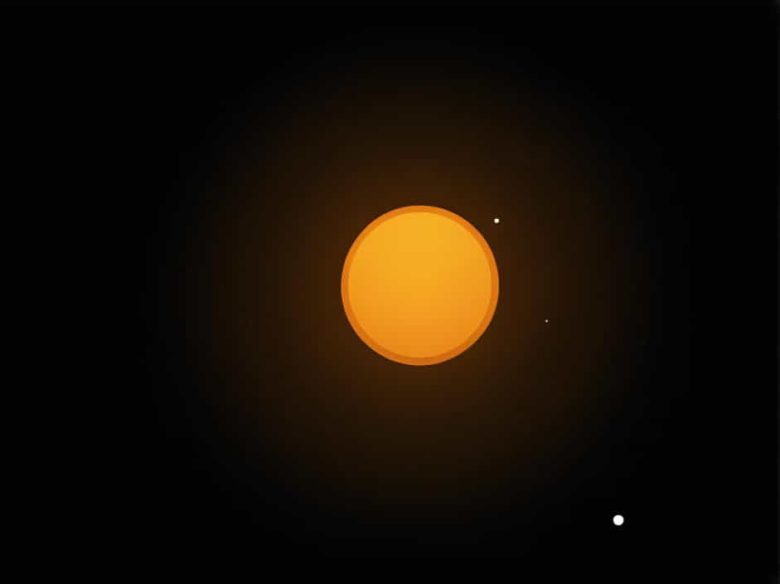If you observe the night sky over several weeks, you may notice that some planets appear to move backward for a short time before continuing in their normal path. This unusual movement is called retrograde motion.
For centuries, retrograde motion puzzled astronomers. Early models of the universe struggled to explain why planets occasionally reversed direction. However, with the introduction of the heliocentric model by Nicolaus Copernicus, this mystery was finally solved.
This topic explains how retrograde motion works in a heliocentric system, why it happens, and how it differs from older geocentric explanations.
What Is Retrograde Motion?
Definition
Retrograde motion is the apparent backward movement of a planet as seen from Earth. Normally, planets move eastward across the sky. But during retrograde motion, they seem to temporarily move westward before returning to their usual path.
Which Planets Exhibit Retrograde Motion?
All planets can exhibit retrograde motion, but it is most noticeable in:
- Mars
- Jupiter
- Saturn
- Venus and Mercury also experience retrograde motion, but their behavior is slightly different due to their orbits being closer to the Sun.
Retrograde Motion in the Geocentric Model
Before the heliocentric model, the dominant view was the geocentric model, which placed Earth at the center of the universe. In this system, planets were thought to move in perfect circles around Earth.
To explain retrograde motion, ancient astronomers, including Ptolemy, proposed the idea of epicycles:
- Planets were thought to move in small circular paths (epicycles) while also traveling along larger circular orbits (deferents) around Earth.
- This complex system worked mathematically, but it did not accurately describe the true motion of planets.
How the Heliocentric Model Explains Retrograde Motion
The heliocentric model, proposed by Copernicus, placed the Sun at the center and showed that planets orbit it at different speeds. This naturally explains retrograde motion without the need for epicycles.
Why Does Retrograde Motion Occur?
Retrograde motion is an optical illusion caused by the different speeds at which planets orbit the Sun.
-
Inner planets move faster than outer planets
- Earth orbits the Sun faster than Mars, Jupiter, and Saturn because it is closer to the Sun.
-
When Earth overtakes an outer planet, retrograde motion occurs
- Imagine two cars on a highway: If a faster car (Earth) overtakes a slower car (Mars), the slower car appears to move backward for a short time from the perspective of the faster car’s driver.
- Similarly, when Earth passes an outer planet, the planet appears to move backward against the background stars.
-
After Earth moves past, the planet resumes its normal motion
- As Earth continues its orbit, the outer planet once again appears to move forward in the sky.
Example: Retrograde Motion of Mars
- Mars normally moves eastward in the sky.
- Every 26 months, Earth catches up to and passes Mars.
- During this period, Mars appears to move westward for several weeks.
- Once Earth moves far enough ahead, Mars resumes its eastward motion.
Observing Retrograde Motion
When Can You See It?
Retrograde motion is visible when:
- A planet is near opposition (directly opposite the Sun in the sky).
- This happens when Earth is between the Sun and the outer planet.
How to Track It?
- Observe the planet over several weeks.
- Compare its position relative to background stars each night.
- When it appears to move backward, you are witnessing retrograde motion.
Key Differences Between the Geocentric and Heliocentric Explanations
| Feature | Geocentric Model (Ptolemy) | Heliocentric Model (Copernicus) |
|---|---|---|
| Center of the Universe | Earth | Sun |
| Planetary Motion | Planets move in circles around Earth | Planets orbit the Sun |
| Explanation for Retrograde Motion | Epicycles (small circular orbits) | Earth overtakes slower planets in orbit |
| Accuracy | Mathematically complex but incorrect | Matches real observations |
The heliocentric model provides a much simpler and more accurate explanation for retrograde motion.
Why Retrograde Motion Was Important in Astronomy
1. It Helped Prove the Heliocentric Model
- Early astronomers, including Galileo Galilei, used telescopic observations to support the heliocentric model.
- The phases of Venus and the motions of Jupiter’s moons showed that not everything revolved around Earth.
2. It Showed That Planets Follow Natural Laws
- Johannes Kepler later refined the model with elliptical orbits instead of perfect circles.
- Isaac Newton explained planetary motion using gravity and inertia.
3. It Helped in Predicting Planetary Positions
- Today, retrograde motion is used in astronomy software to accurately track planetary positions.
Retrograde motion, once a great mystery, is now understood as a natural result of planetary orbits in the heliocentric model. The apparent backward movement of planets is simply an optical illusion caused by Earth’s faster orbit overtaking outer planets.
This phenomenon played a crucial role in the history of astronomy, helping to shift our understanding from an Earth-centered universe to a Sun-centered solar system. Next time you observe a planet’s motion, you might just catch a glimpse of this fascinating effect in action!



